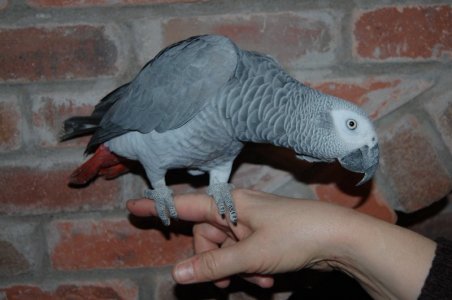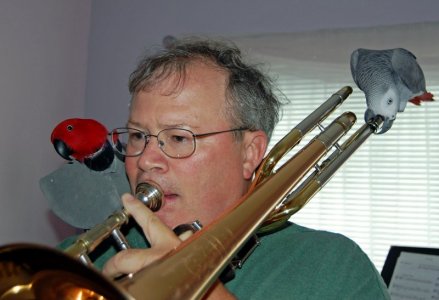Sorry - long post ahead.
I mentioned elsewhere that I'm first and foremost a bird guy. I've been involved with one bird species or another since the mid-1980s. I've owned (or have been owned) by a number of parrots along the way, but most notably, I've fostered even more. These run the gamut from macaws (blue and gold and green-wing) to cockatoos (these birds need a special kind of human to deal with them) to eclectus to Congo African greys (my favorite). Had fostered a lorikeet at one time (exceptionally nasty) and my first bird was a cockatiel. Let's not forget the Amazon parrots of various colorations.
A couple of photos for you, but let me say up front: parrots are not for everybody. They are messy, they require food that goes WAAAAAAAAY beyond the "Polly want a cracker?" nonsense; their housing in a cage or T-stand requires a deep dive into your bank account, and every part about these "pets" scream "exotic".
Which they are.
For example -- every five days, I make up a batch of veggies, which includes kale, carrots, sweet peppers, broccoli, apple, zucchini, yellow squash and rough-chop them in a food processor. That's not enough, though. I have to put the chopped veggies in a towel to absorb excess water, and then put the food in a container for a few days. About once per month, I make and cook a batch of what I call "perch mix". This includes field corn, three different types of beans (Navy, black-eyed peas, and split peas), sweet potato, long grain rice, old-fashioned oatmeal, a thin pasta, raisins, frozen peas (cooked, of course, but not very long), eggshells, and a cinnamon stick.
Jackie, my Congo grey, gets three tablespoons of perch mix and three tablespoons of veggies per day. She gets a bowl of water (in which she sometimes takes a bath), and I have at least two shreddable toys for her along with a pine cone, also for shredding. She gets an almond or two as a snack, then there's another cooked food item I make and freeze. Cooked chicken bones are a favorite (she eats the marrow), and tiny pieces of cheese are OK. No seeds at all.
She makes an ungodly mess, which I have to clean every day. Her cage also has to be cleaned every day.
Birds like Jackie can also be destructive. She did a great job in tearing apart a set of venetian blinds and she chewed through some dry wall trim.
She has a definite bedtime of 5:30 PM and if I don't see to putting her to bed in her sleep cage (another area that must be cleaned), she screams until I put her away.
Parrots are a challenge, but they are fascinating creatures. Think of one thing -- dogs and humans have been "together" for tens of thousands of years. Parrot and human interactions have really only been a thing for a couple-three hundred years. In essence, parrots are still fundamentally "wild" yet they have figured out how to interact with us. Humans, on the other hand, haven't quite gotten to that same level yet.
Phoebe (Congo African grey) in 2009: An incredible talker.

Phoebe and Papagena with me while I practice bass trombone. Papagena has a suede "cape" on her to try and reduce her feather-picking. Didn't really work:

I mentioned elsewhere that I'm first and foremost a bird guy. I've been involved with one bird species or another since the mid-1980s. I've owned (or have been owned) by a number of parrots along the way, but most notably, I've fostered even more. These run the gamut from macaws (blue and gold and green-wing) to cockatoos (these birds need a special kind of human to deal with them) to eclectus to Congo African greys (my favorite). Had fostered a lorikeet at one time (exceptionally nasty) and my first bird was a cockatiel. Let's not forget the Amazon parrots of various colorations.
A couple of photos for you, but let me say up front: parrots are not for everybody. They are messy, they require food that goes WAAAAAAAAY beyond the "Polly want a cracker?" nonsense; their housing in a cage or T-stand requires a deep dive into your bank account, and every part about these "pets" scream "exotic".
Which they are.
For example -- every five days, I make up a batch of veggies, which includes kale, carrots, sweet peppers, broccoli, apple, zucchini, yellow squash and rough-chop them in a food processor. That's not enough, though. I have to put the chopped veggies in a towel to absorb excess water, and then put the food in a container for a few days. About once per month, I make and cook a batch of what I call "perch mix". This includes field corn, three different types of beans (Navy, black-eyed peas, and split peas), sweet potato, long grain rice, old-fashioned oatmeal, a thin pasta, raisins, frozen peas (cooked, of course, but not very long), eggshells, and a cinnamon stick.
Jackie, my Congo grey, gets three tablespoons of perch mix and three tablespoons of veggies per day. She gets a bowl of water (in which she sometimes takes a bath), and I have at least two shreddable toys for her along with a pine cone, also for shredding. She gets an almond or two as a snack, then there's another cooked food item I make and freeze. Cooked chicken bones are a favorite (she eats the marrow), and tiny pieces of cheese are OK. No seeds at all.
She makes an ungodly mess, which I have to clean every day. Her cage also has to be cleaned every day.
Birds like Jackie can also be destructive. She did a great job in tearing apart a set of venetian blinds and she chewed through some dry wall trim.
She has a definite bedtime of 5:30 PM and if I don't see to putting her to bed in her sleep cage (another area that must be cleaned), she screams until I put her away.
Parrots are a challenge, but they are fascinating creatures. Think of one thing -- dogs and humans have been "together" for tens of thousands of years. Parrot and human interactions have really only been a thing for a couple-three hundred years. In essence, parrots are still fundamentally "wild" yet they have figured out how to interact with us. Humans, on the other hand, haven't quite gotten to that same level yet.
Phoebe (Congo African grey) in 2009: An incredible talker.

Phoebe and Papagena with me while I practice bass trombone. Papagena has a suede "cape" on her to try and reduce her feather-picking. Didn't really work:



